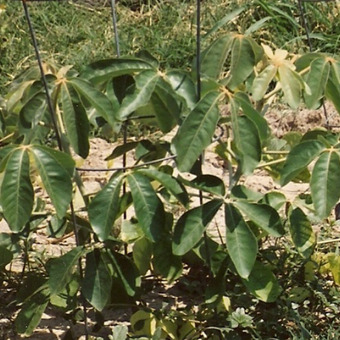A large spreading tree. It has a sturdy trunk up to 1 m across. It usually grows 7-9 m tall but can be 24 m tall. The crown is rounded. It has smooth green or golden bark. It has stubby branches. There are reddish-brown furry hairs on the young branches and stalks. These disappear with age. The plant has a cloudy latex. The leaves are produced one after another along the stalk. The leaves are compound and leaflets arranged like fingers on a hand. The leaves have 3-7 leaflets and these are 5-13 cm long and 2.5-9 cm wide. They are velvety grey underneath. The leaf stalks are 15 cm long. The base of the leaflets is unequal. They are dark green on top and paler underneath. The leaves have star shaped hairs in both sides. There are 1-3 flat dark glands where the leaf joins the stalk. It loses its leaves during summer. The male and female flowers on on different plants. The buds are rusty red and velvety and on long furry stalks. The flowers are small and white or yellow. The female flowers are more tightly grouped together than the male flowers. The fruit is egg shaped and 35 mm long by 25 mm wide. They are velvety. When young they are hairy and when mature have a tough brown shell. There is a thick layer of pulp around a very hard and finely pitted stone. Inside this are 2 light coloured kernels. The fruit are edible. The kernel is edible.
Leaflets elliptic-ovate to oblanceolate, rarely 3-lobed; median leaflet 5–18 × 2–9 cm, the lateral leaflets slightly smaller; all leaflets obtuse or acute and shortly acuminate at the apex, usually somewhat asymmetrically rounded-cuneate at the base, entire or subentire, edged with marginal dark green gland dots on upper or lower surfaces, densely ferrugineous or fulvous stellate-pubescent on upper surface, later glabrescent, paler or whitish stellate-tomentose beneath; lateral nerves in 6–16 pairs.
Male flowers: pedicels 2–5 mm long; calyx lobes 5 × 2.5–3 mm, elliptic-oblong, obtuse, stellate-pubescent without and within; petals 6–7 × 2–3 mm, elliptic-oblong, emarginate-subtruncate at the apex, rounded at the base, glabrous except within at the base, pale lemon-yellow to whitish, drying dark brown; disk glands c. 1 × 1 mm; stamens c. 7 mm long, anthers 0.75 × 0.5 mm.
Female flowers: pedicels 7–10 mm, stouter than in the male flowers; calyx lobes 8–9 × 5–6 mm, broadly ovate, subacute or obtuse, indumented as in the male; petals 9 × 4 mm, glabrous, otherwise more or less as in the male; disk 4 mm in diameter; ovary 7 × 5 × 3 mm, densely stellate-pubescent; styles 5 mm long.
Fruit 3–5 × 2–3.5 cm when dried, up to 7 × 5 cm when fresh, densely stellate-tomentose at first, later glabrescent, green, becoming pale yellow; exopcarp thin, mesocarp 3–4 mm thick, endocarp 4–5 mm thick.
Twigs thick, exuding white gum; twigs, petioles and inflorescence axes ferrugineous stellate-pubescent at first, later scurfily stellate-pulverulent.
Bark pale grey, whitish or light brown, smooth at first, later becoming reticulate and flaking, and grey-green beneath.
Petioles 6–25 cm long; glands 2–4, usually at the petiole apex, prominent, green; petiolules 0.5–1.5 cm long.
A shrub, or tree up to 20 m tall, with a rounded or spreading crown, and with a trunk up to c. 1 m d.b.h.
Female inflorescences 5–6 × 2–3 cm; bracts as in the male.
Male inflorescences 10–22 × 4–8 cm; bracts 3–10 mm long.
Seeds 1.8–2.5 × 1.6–2 cm, compressed-ellipsoid.
Leaves digitately compound, (3)5–7-foliolate.
Stipules 3–5 × 2–3 mm.
Wood white, very soft.


